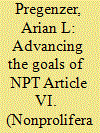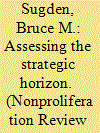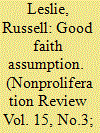|
|
|
Sort Order |
|
|
|
Items / Page
|
|
|
|
|
|
|
| Srl | Item |
| 1 |
ID:
083840


|
|
|
|
|
| Publication |
2008.
|
| Summary/Abstract |
International technical cooperation on issues relevant to the challenges of nuclear disarmament can demonstrate commitment to obligations under Article VI of the Treaty on the Non-Proliferation of Nuclear Weapons, strengthen the security of fissile materials and weapons, and develop technical approaches to support more ambitious disarmament activities in the future. Including non-nuclear weapon states would ensure that their views are taken into account and would invest them in developing solutions to key challenges. This article discusses three areas for technical cooperation that would build on past activities and that could produce such benefits as improved protection, control, and accounting of nuclear weapons and fissile material; enhanced transparency for nuclear weapon complexes; and mechanisms for international management of sensitive civilian nuclear facilities. International cooperation in each of these areas could provide a technical basis for pursuing possible future disarmament negotiations and substantively demonstrate commitment to Article VI.
|
|
|
|
|
|
|
|
|
|
|
|
|
|
|
|
| 2 |
ID:
083838


|
|
|
|
|
| Publication |
2008.
|
| Summary/Abstract |
Two sets of factors undermine the growing calls for a stronger U.S. role in leading the world to complete nuclear weapons disarmament. First, the history of post-Cold War nuclear proliferation shows that U.S. conventional military prowess and regional security concerns are more powerful drivers of global nuclear proliferation than U.S. nuclear policy. Thus, the relatively weak relationship between U.S. nuclear policy and the actions of proliferators is not a compelling justification for a greater U.S. effort toward a nuclear-free world. Second, in securing its vital interests, the United States must guard against various risks in a non-nuclear world, namely an increased likelihood of war between former nuclear powers; less insurance against disruptive technological challenges to U.S. military power; nuclear breakout; and the clandestine spread of nuclear knowledge. Despite these factors, the United States may still be able to reduce its nuclear arsenal. This article proposes that nuclear policy prescription should be couched in a diagnostic assessment of the international security environment to identify emerging and long-term challenges and opportunities that could affect the strategic position of the United States and the size and roles of its nuclear forces
|
|
|
|
|
|
|
|
|
|
|
|
|
|
|
|
| 3 |
ID:
083835


|
|
|
|
|
| Publication |
2008.
|
| Summary/Abstract |
This article explores the value of effective brand messaging to achieve public policy goals. Policy makers and advocacy organizations working toward a nuclear-free world need to become more effective communicators with the general public if they wish to build broad-based political support. Effective communication includes: a specific long-range goal, an urgent time schedule, a plan to marshal time and resources, and the ability to communicate the goal in simple language. With a unique brand name and tagline for a specific nuclear-free-world proposal, policy makers and advocacy groups can better facilitate communication between citizens and their elected representatives. Well-executed branding also serves to: simplify a complex issue, influence public opinion, be memorable and emotionally appealing, and help unify diverse groups around a common platform. By developing a common language between policy makers, politicians, and the general public, a complex and seemingly insurmountable issue can be transformed into a coherent and achievable platform.
|
|
|
|
|
|
|
|
|
|
|
|
|
|
|
|
| 4 |
ID:
083836


|
|
|
|
|
| Publication |
2008.
|
| Summary/Abstract |
This article examines whether and how the delegation of sovereign regulative powers in the nuclear field by states to supranational regional authorities can further nonproliferation purposes. More precisely, it asks whether the second Rome Treaty, which instituted the European Community of Atomic Energy (Euratom), could serve as a model for the creation of other regional authorities in the nuclear field, particularly among Middle Eastern and Arab nations. It argues that the Euratom Treaty provides interesting technical provisions, particularly regarding 1) safeguards against the diversion of fissile materials by state and non-state actors, 2) confidence-building measures for state actors when they establish R&D in nuclear technologies, and 3) fuel supply assurances for state actors. Building on archival research of the Euratom Treaty negotiations and the Euratom Commission, the article argues that, today, supranational provisions included in the Euratom Treaty would have stronger nonproliferation effects than looser forms of international cooperation. However, the article also points to specific weaknesses in the Euratom Treaty and outlines how legal scholars and diplomats can avoid some of its pitfalls.
|
|
|
|
|
|
|
|
|
|
|
|
|
|
|
|
| 5 |
ID:
083839


|
|
|
|
|
| Publication |
2008.
|
| Summary/Abstract |
Export controls and international safeguards are central to ensuring international confidence in the peaceful uses of nuclear materials and technologies and to achieving adequate oversight on the transfer and use of nuclear materials, technology, and equipment required for the development of proliferation-sensitive parts of the nuclear fuel cycle. Although the independent strengths of export controls and international safeguards rely largely on universal adherence, there may be opportunities to exploit the shared strengths of these systems. This article provides background information on the separate evolution of export controls and international safeguards, considers how these two elements of the nonproliferation regime interact, and identifies some possible avenues that could, over time, lead to wholly integrated activities.
|
|
|
|
|
|
|
|
|
|
|
|
|
|
|
|
| 6 |
ID:
083837


|
|
|
|
|
| Publication |
2008.
|
| Summary/Abstract |
There are a number of competing paradigms on nonproliferation issues, each with their own self-consistent set of axioms that have to be dealt with on their own terms. If these different approaches are not appropriately acknowledged during discussions, they can become a permanent barrier to the resolution of underlying issues. This article identifies some of the key interest groups that are involved in discussions of nuclear nonproliferation issues and seeks to delineate the paradigmatic differences between these groups. These differences in approach can give rise to the perception that one or more of the parties to any discussion are arguing in bad faith. While bad faith may be a cause of at least some of the disputes that arise on nonproliferation issues, assuming bad faith as an explanation for these differences is counterproductive; it prevents any serious discussion of the issues underlying such disputes and obstructs attempts to reach a common understanding
|
|
|
|
|
|
|
|
|
|
|
|
|
|
|
|
| 7 |
ID:
083834


|
|
|
|
|
| Publication |
2008.
|
| Summary/Abstract |
Nuclear deterrence is sometimes treated as a known quantity-a definite thing that keeps us safe and ensures our security. It has also often been used as a justification for possessing nuclear weapons. Nuclear deterrence, however, is based on an unexamined notion: the belief that the threat to destroy cities provides decisive leverage. An examination of history (including recent reinterpretations of the bombing of Hiroshima) shows that destroying cities rarely affects the outcome of wars. How is it possible that an action that is unlikely to be decisive can make an effective threat? Recent work on terrorism suggests that attacks against civilians are often not only ineffective but also counterproductive. And a review of the practical record of nuclear deterrence shows more obvious failures than obvious successes. Given this, the record of nuclear deterrence is far more problematic than most people assume. If no stronger rationale for keeping these dangerous weapons can be contrived, perhaps they should be banned
|
|
|
|
|
|
|
|
|
|
|
|
|
|
|
|
|
|
|
|
|